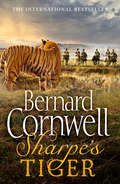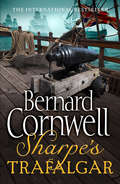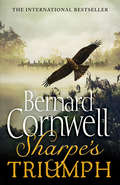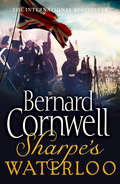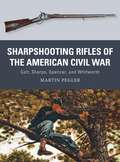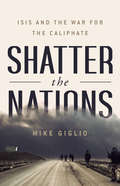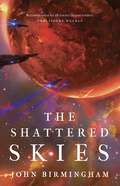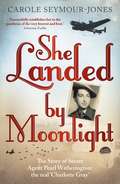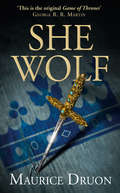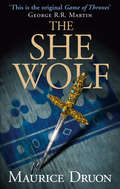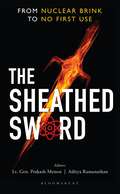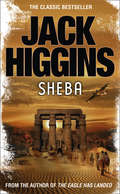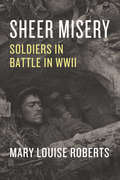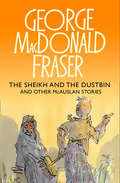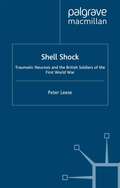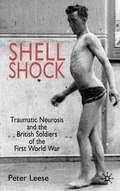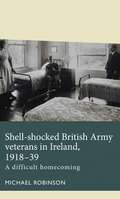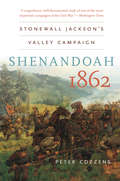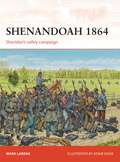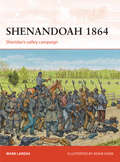- Table View
- List View
Sharpe’s Tiger: The Siege Of Seringapatam 1799 (The Sharpe Series #1)
by Bernard CornwellWhen a senior British officer is captured by the Tippoo of Mysore’s forces, Richard Sharpe is offered a chance to attempt a rescue, which in turn offers an escape from the tyrannical Sergeant Obadiah Hakeswill.
Sharpe’s Trafalgar: The Battle Of Trafalgar, 21 October 1805 (The Sharpe Series #4)
by Bernard CornwellRichard Sharpe, travelling home aboard the ‘Revenant’, meets Admiral Nelson and his fleet, on what was a calm October day off Cape Trafalgar.
Sharpe’s Triumph: The Battle Of Assaye, September 1803 (The Sharpe Series #2)
by Bernard CornwellRichard Sharpe, now a sergeant, and his unit are attacked by apparent allies.
Sharpe’s Waterloo: The Waterloo Campaign, 15 - 18 June, 1815 (The Sharpe Series #20)
by Bernard CornwellSPECIAL ANNIVERSARY eBook edition of Bernard Cornwell’s classic novel, with a new foreword by the author.
Sharpshooting Rifles of the American Civil War: Colt, Sharps, Spencer, and Whitworth (Weapon #56)
by Martin Pegler Johnny Shumate Alan GillilandAt the outset of the American Civil War, the Union Army's sharpshooters were initially equipped with the M1855 Colt revolving rifle, but it was prone to malfunction. Instead, the North's sharpshooters preferred the Sharps rifle, an innovative breech-loading weapon capable of firing up to ten shots per minute – more than three times the rate of fire offered by the standard-issue Springfield .58-caliber rifled musket. Other Union sharpshooters were equipped with the standard-issue Springfield rifled musket or the .56-56-caliber Spencer Repeating Rifle.Conversely, the Confederacy favoured the Pattern 1853 Enfield rifled musket for its sharpshooters and also imported from Britain the Whitworth Rifle, a .45-caliber, single-shot, muzzle-loading weapon distinguished by its use of a twisted hexagonal barrel. Featuring specially commissioned artwork, this is the engrossing story of the innovative rifles that saw combat in the hands of sharpshooters on both sides during the Civil War.
Sharpshooting Rifles of the American Civil War: Colt, Sharps, Spencer, and Whitworth (Weapon #56)
by Martin Pegler Johnny Shumate Alan GillilandAt the outset of the American Civil War, the Union Army's sharpshooters were initially equipped with the M1855 Colt revolving rifle, but it was prone to malfunction. Instead, the North's sharpshooters preferred the Sharps rifle, an innovative breech-loading weapon capable of firing up to ten shots per minute – more than three times the rate of fire offered by the standard-issue Springfield .58-caliber rifled musket. Other Union sharpshooters were equipped with the standard-issue Springfield rifled musket or the .56-56-caliber Spencer Repeating Rifle.Conversely, the Confederacy favoured the Pattern 1853 Enfield rifled musket for its sharpshooters and also imported from Britain the Whitworth Rifle, a .45-caliber, single-shot, muzzle-loading weapon distinguished by its use of a twisted hexagonal barrel. Featuring specially commissioned artwork, this is the engrossing story of the innovative rifles that saw combat in the hands of sharpshooters on both sides during the Civil War.
Shatter the Nations: ISIS and the War for the Caliphate
by Mike GiglioUnflinching dispatches of an embedded war reporter covering ISIS and the unlikely alliance of forces who came together to defeat it.The battle to defeat ISIS was an unremittingly brutal and dystopian struggle, a multi-sided war of gritty local commandos and militias. Mike Giglio takes readers to the heart of this shifting, uncertain conflict, capturing the essence of a modern war.At its peak, ISIS controlled a self-styled "caliphate" the size of Great Britain, with a population cast into servitude that numbered in the millions. Its territory spread across Iraq and Syria as its influence stretched throughout the wider world.Giglio tells the story of the rise of the caliphate and the ramshackle coalition--aided by secretive Western troops and American airstrikes--that was assembled to break it down village by village, district by district. The story moves from the smugglers, traffickers, and jihadis working on the ISIS side to the victims of its zealous persecution and the local soldiers who died by the thousands to defeat it. Amid the battlefield drama, culminating in a climactic showdown in Mosul, is a dazzlingly human portrait of the destructive power of extremism, and of the tenacity and astonishing courage required to defeat it.
Shatter the Nations: ISIS and the War for the Caliphate
by Mike GiglioUnflinching dispatches of an embedded war reporter covering ISIS and the unlikely alliance of forces who came together to defeat it.The battle to defeat ISIS was an unremittingly brutal and dystopian struggle, a multi-sided war of gritty local commandos and militias. Mike Giglio takes readers to the heart of this shifting, uncertain conflict, capturing the essence of a modern war.At its peak, ISIS controlled a self-styled "caliphate" the size of Great Britain, with a population cast into servitude that numbered in the millions. Its territory spread across Iraq and Syria as its influence stretched throughout the wider world.Giglio tells the story of the rise of the caliphate and the ramshackle coalition--aided by secretive Western troops and American airstrikes--that was assembled to break it down village by village, district by district. The story moves from the smugglers, traffickers, and jihadis working on the ISIS side to the victims of its zealous persecution and the local soldiers who died by the thousands to defeat it. Amid the battlefield drama, culminating in a climactic showdown in Mosul, is a dazzlingly human portrait of the destructive power of extremism, and of the tenacity and astonishing courage required to defeat it.
The Shattered Skies (The Cruel Stars Trilogy #2)
by John BirminghamCenturies after they were defeated and exiled to dark space, The Sturm have returned. The Sturm, an empire of species purists, have returned from the farthest reaches of Dark Space to wage a war against what they call mutants and borgs: any human being with genetic or neural engineering. In a sneak attack on the galaxy-spinning networks, they overwhelmed almost all of humanity's defenses, blasting dark code that transformed anyone connected to the system into a mindless psychotic killer. The Sturm's victory seemed complete, their final triumph inevitable, until one small band of intrepid, unlikely heroes struck back.Commander Lucinda Hardy and Admiral Frazer McLennan used the Armadalen Navy's final surviving warship to fend off the Sturm, destroying the massed power of an entire Attack Fleet. With brilliant tactics, this ragtag crew sent the Sturm running, managing to save Princess Alessia, the sole surviving heir to the gigantic Montanblanc Corporation and perhaps Earth's only remaining senator.Now left with the remains of a fallen civilization, they must work together to rebuild what was lost and root out the numberless enemies of Earth. The Sturm invaders remain vastly more powerful – and they may not be the only threat lurking in the darkness of space...
She Landed By Moonlight: The Story of Secret Agent Pearl Witherington: the 'real Charlotte Gray'
by Carole Seymour-JonesOn the night of the 22 September 1943 Pearl Witherington, a twenty-nine-year-old British secretary and agent of the Special Operations Executive (SOE), was parachuted from a Halifax bomber into Occupied France. Like Sebastian Faulks' heroine, Charlotte Gray, Pearl had a dual mission: to fight for her beloved, broken France and to find her lost love. Pearl's lover was a Parisian parfumier turned soldier, Henri Cornioley, who had been taken prisoner while serving in the French Logistics Corps and subsequently escaped from his German POW camp. Agent Pearl Witherington's wartime record is unique and heroic. As the only woman agent in the history of SOEs in France to have run a network, she became a fearless and legendary guerrilla leader organising, arming and training 3,800 Resistance fighters. Probably the greatest female organiser of armed maquisards in France, the woman whom her young troops called 'Ma Mère', Pearl lit the fires of Resistance in Central France so that Churchill's famous order to 'set Europe ablaze', which had brought SOE into being, finally came to pass. Pearl's story takes us from her harsh, impoverished childhood in Paris, to the lonely forests and farmhouses of the Loir-et-Cher where she would become a true 'warrior queen'. Shortly before Pearl's death in 2008, the Queen presented her with a CBE in Paris. While male agents and Special Force Jedburghs received the DSO or Military Cross, an ungrateful country had forgotten Pearl. She had been offered a civilian decoration in 1945 which she refused, saying 'There was nothing civil about what I did.' But what pleased her most was to receive her Parachute Wings, for which she had waited over 60 years. Two RAF officers travelled to her old people's home and she was finally able to pin the coveted wings on her lapel. Pearl died in February 2008 aged 93.
The She-Wolf (The Accursed Kings #5)
by Maurice Druon“This is the original Game of Thrones.” George R.R. Martin.
The She-Wolf (The Accursed Kings #5)
by Maurice Druon“This is the original Game of Thrones.” George R.R. Martin.
The Sheathed Sword: From Nuclear Brink to No First Use
by Prakash Menon Aditya RamanathanAfter a brief interlude following the Cold War, nuclear weapons have regained their prominent place in world affairs. Yet our current nuclear age will not be a replay of the Cold War. New technologies, changing political contexts and the death of old arms-control agreements mean that today's nuclear strategists have to navigate unchartered waters filled with fresh perils. Unfortunately, the consequences of failure in the nuclear world can be catastrophic. The immediate imperative today is to lower the possibility of nuclear weapons use during a crisis or conflict involving nuclear powers. While deliberate or pre-emptive nuclear use is less likely, the rising danger of our time is that nuclear weapons will be employed due to some combination of miscommunication, misjudgment, misperception and sheer accident.The Sheathed Sword: From Nuclear Brink to No First Use is a collection of essays by leading scholars and practitioners on the role of nuclear weapons in global security. The contributors examine how individual states view nuclear weapons, the devastating effects of nuclear war on the world's climate and the issues around nuclear no first use. They also debate the feasibility and desirability of a global no-first-use (GNFU) agreement.
The Sheathed Sword: From Nuclear Brink to No First Use
by Prakash Menon Aditya RamanathanAfter a brief interlude following the Cold War, nuclear weapons have regained their prominent place in world affairs. Yet our current nuclear age will not be a replay of the Cold War. New technologies, changing political contexts and the death of old arms-control agreements mean that today's nuclear strategists have to navigate unchartered waters filled with fresh perils. Unfortunately, the consequences of failure in the nuclear world can be catastrophic. The immediate imperative today is to lower the possibility of nuclear weapons use during a crisis or conflict involving nuclear powers. While deliberate or pre-emptive nuclear use is less likely, the rising danger of our time is that nuclear weapons will be employed due to some combination of miscommunication, misjudgment, misperception and sheer accident.The Sheathed Sword: From Nuclear Brink to No First Use is a collection of essays by leading scholars and practitioners on the role of nuclear weapons in global security. The contributors examine how individual states view nuclear weapons, the devastating effects of nuclear war on the world's climate and the issues around nuclear no first use. They also debate the feasibility and desirability of a global no-first-use (GNFU) agreement.
Sheba
by Jack HigginsThe Lost Temple of Sheba is not just a biblical legend. A German archaeologist has found it. The Nazis have claimed it. And one American explorer has stumbled upon their secret - a plot that could change the course of World War II.
Sheer Misery: Soldiers in Battle in WWII
by Mary Louise RobertsMarching across occupied France in 1944, American GI Leroy Stewart had neither death nor glory on his mind: he was worried about his underwear, which was engaged in a relentless crawl of its own. Similar complaints of physical discomfort pervade infantrymen’s memories of the European theater, whether the soldiers were British, American, German, or French. Wet, freezing misery with no end in sight—this was life for millions of enlisted men during World War II. Sheer Misery trains a humane and unsparing eye on the corporeal experiences of the soldiers who fought in Belgium, France, and Italy during the last two years of the war. In the horrendously unhygienic and often lethal conditions of the front line, their bodies broke down, stubbornly declaring their needs for warmth, rest, and good nutrition. Feet became too swollen to march, fingers too frozen to pull triggers; stomachs cramped, and diarrhea stained underwear and pants. Turning away from the accounts of high-level military strategy that dominate many WWII chronicles, acclaimed historian Mary Louise Roberts instead relies on diaries and letters to bring to life visceral sense memories like the moans of the “screaming meemies,” the acrid smell of cordite, and the shockingly mundane sight of rotting corpses. As Roberts writes, “For soldiers who fought, the war was above all about their bodies.”
Sheer Misery: Soldiers in Battle in WWII
by Mary Louise RobertsMarching across occupied France in 1944, American GI Leroy Stewart had neither death nor glory on his mind: he was worried about his underwear, which was engaged in a relentless crawl of its own. Similar complaints of physical discomfort pervade infantrymen’s memories of the European theater, whether the soldiers were British, American, German, or French. Wet, freezing misery with no end in sight—this was life for millions of enlisted men during World War II. Sheer Misery trains a humane and unsparing eye on the corporeal experiences of the soldiers who fought in Belgium, France, and Italy during the last two years of the war. In the horrendously unhygienic and often lethal conditions of the front line, their bodies broke down, stubbornly declaring their needs for warmth, rest, and good nutrition. Feet became too swollen to march, fingers too frozen to pull triggers; stomachs cramped, and diarrhea stained underwear and pants. Turning away from the accounts of high-level military strategy that dominate many WWII chronicles, acclaimed historian Mary Louise Roberts instead relies on diaries and letters to bring to life visceral sense memories like the moans of the “screaming meemies,” the acrid smell of cordite, and the shockingly mundane sight of rotting corpses. As Roberts writes, “For soldiers who fought, the war was above all about their bodies.”
The Sheik and the Dustbin (The McAuslan Stories #3)
by George MacDonald FraserPrivate McAuslan, J., The Dirtiest Soldier in the World (alias the Tartan Caliban, or the Highland Division's answer to Pekin Man) first demonstrated his unfitness for the service in' The General Danced at Dawn'.
Shell Shock: Traumatic Neurosis and the British Soldiers of the First World War
by P. LeeseTo the British soldiers of the Great War who heard about it, 'shell shock' was uncanny, amusing and sad. To those who experienced it, the condition was shameful, unjustly stigmatized and life-changing. The first full-length study of the British 'shell shocked' soldiers of the Great War combines social and medical history to investigate the experience of psychological casualties on the Western Front, in hospitals, and through their postwar lives. It also investigates the condition's origin and consequences within British culture.
Shell Shock: Traumatic Neurosis And The British Soldiers Of The First World War (PDF)
by Peter LeeseTo the British soldiers of the Great War who heard about it, 'shell shock' was uncanny, amusing and sad. To those who experienced it, the condition was shameful, unjustly stigmatized and life-changing. The first full-length study of the British 'shell shocked' soldiers of the Great War combines social and medical history to investigate the experience of psychological casualties on the Western Front, in hospitals, and through their postwar lives. It also investigates the condition's origin and consequences within British culture.
Shell-shocked British Army veterans in Ireland, 1918-39: A difficult homecoming (Disability History)
by Michael RobinsonWith a focus on mental illness, Shell-shocked British Army veterans in Ireland provides the first in-depth investigation of disabled Great War veterans in Ireland. The book is a result of five years of researching previously untouched archival sources including psychiatric records of former patients otherwise closed to the public. The remit of the work contributes to various historiographical fields including disability history, the social history of medicine, the cultural history of modern war, the history of psychiatry and Irish studies. It also seeks to extend the scope of the First World War with an emphasis on how war-induced disability and trauma continued to affect large numbers of ex-servicemen beyond the official cessation of the conflict.
Shell-shocked British Army veterans in Ireland, 1918-39: A difficult homecoming (Disability History)
by Michael RobinsonWith a focus on mental illness, Shell-shocked British Army veterans in Ireland provides the first in-depth investigation of disabled Great War veterans in Ireland. The book is a result of five years of researching previously untouched archival sources including psychiatric records of former patients otherwise closed to the public. The remit of the work contributes to various historiographical fields including disability history, the social history of medicine, the cultural history of modern war, the history of psychiatry and Irish studies. It also seeks to extend the scope of the First World War with an emphasis on how war-induced disability and trauma continued to affect large numbers of ex-servicemen beyond the official cessation of the conflict.
Shenandoah 1862: Stonewall Jackson’s Valley Campaign (Civil War America)
by Peter CozzensOne of the most intriguing and storied episodes of the Civil War, the 1862 Shenandoah Valley Campaign has heretofore been related only from the Confederate point of view. Moving seamlessly between tactical details and analysis of strategic significance, Peter Cozzens presents a balanced, comprehensive account of a campaign that has long been romanticized but little understood. He offers new interpretations of the campaign and the reasons for Stonewall Jackson's success, demonstrates instances in which the mythology that has come to shroud the campaign has masked errors on Jackson's part, and provides the first detailed appraisal of Union leadership in the Valley Campaign, with some surprising conclusions.
Shenandoah 1864: Sheridan’s valley campaign (Campaign)
by Adam Hook Mark LardasFor three years of war the Union and the Confederacy had battled over the picturesque Shenandoah Valley of Virginia. Nestled between the Blue Ridge Mountains to the east and the Ridge-and-Valley Appalachians to the west, the valley served as the granary for the Army of Northern Virginia. It provided bread and beef to feed this shield of the Confederacy and remounts for its cavalry. This beautifully illustrated study explores one of the major campaigns of the Civil War in 1864, which saw a decisive victory for the Union forces under Sheridan and featured some of the most famous commanders of the war, including Philip Sheridan, Jubal Early, George Armstrong Custer, John B. Gordon and George Crook.
Shenandoah 1864: Sheridan’s valley campaign (Campaign #274)
by Mark Lardas Mr Adam HookFor three years of war the Union and the Confederacy had battled over the picturesque Shenandoah Valley of Virginia. Nestled between the Blue Ridge Mountains to the east and the Ridge-and-Valley Appalachians to the west, the valley served as the granary for the Army of Northern Virginia. It provided bread and beef to feed this shield of the Confederacy and remounts for its cavalry. This beautifully illustrated study explores one of the major campaigns of the Civil War in 1864, which saw a decisive victory for the Union forces under Sheridan and featured some of the most famous commanders of the war, including Philip Sheridan, Jubal Early, George Armstrong Custer, John B. Gordon and George Crook.
